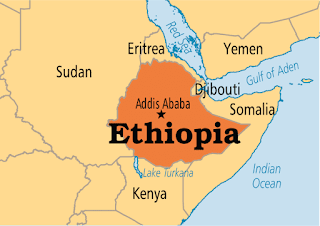Ethiopia outshines Nigeria
It’s just the simple truth that
Nigeria is currently held down by senseless leadership moves.
News about Nigeria on the world
stage has it that it’s now the poverty capital of the world, its debt profile
is getting uncontrollable, and that while Egypt generated 10,000 megawatts of
electricity in just 18 months, Nigeria hasn’t been able to generate any
worthwhile amount in two decades of democracy.
It’s not a matter of being
unpatriotic as a Nigerian to talk about its backwardness when it’s in the plain
view of the whole world.
While Nigeria should be setting
the pace for not just Africa but the whole world considering its vast human and
natural resources, it’s rather abusing human rights and formulating
retrogressive policies.
But while Nigeria is failing,
Ethiopia is impressing, even if it’s in just one regard.
It has received well-deserved
commendation from the world for planting 350 million trees in a single day, out
of its target of 4 billion trees, at a ratio of 40 trees per person, to be
planted.
At this time that the world is in
the serious problem of climate change, Ethiopia really must be commended for
this significant achievement of setting a new world record of most trees
planted in a single day.
“Climate change impacts have
greatly affected Ethiopia in terms of flooding, drought and food insecurity,”
says Margaret Oduk, Programme Coordinator of UN Environment Programme’s (UNEP)
Liaison Office to the African Union Commission, the United Nations Economic
Commission for Africa, and Ethiopia.
“On one hand, lowland areas are
experiencing increased temperatures and prolonged droughts which in turn affect
livestock rearing. On the other hand, highland areas are experiencing more
intense and/or irregular rainfall, which together with high temperatures result
in decreased agricultural production.
“In 2017 alone, the country lost
over 2 million animals due to drought. Furthermore, environmental
degradation—exacerbated by increased human use of land, unsustainable
agricultural practices, indiscriminate grazing of animals and the collection of
firewood for household energy—has contributed to reduced land cover and
protection against soil erosion, which in turn is further reducing forest
cover.”
To address this situation,
Ethiopia has embarked on an ambitious tree-planting programme, and recently
planted over 350 million trees in a single day, breaking what is said to be a
new world record.
Under the country’s National
Green Development programme—launched in May 2019 in a bid to combat climate
change and environmental degradation—Ethiopia plans to plant 4 billion trees on
1.5 million hectares across the country: 40 trees per person.
The government recently
established a five-member expert group to monitor and assess the tree-planting
programme. Members are drawn from four ministries, the United Nations
Development Programme, as well as Ethiopia’s Environment, Forest and Climate
Change Commission. The plan is to devolve responsibility to relevant
institutions and local authorities for planting, monitoring progress, and
improving the survivability of seedlings.
Ethiopia has a huge and youthful
population, with 69 percent of its 104 million people under the age of 29. The
prime minister has called for youth to engage voluntarily in their respective
communities to support the campaign.
One of the challenges with tree
planting has been seedling survival, which depends on many factors. Some of
them are outside human control—like drought or natural disasters—while others
are difficult to control—like overgrazing by animals, which can require
fencing, or at least good natural resource management.
“Ethiopia is aware of the need to
ensure long-term survival of tree seedlings. The country is putting in place
all necessary mechanisms and has asked for international support to help ensure
the trees grow to maturity,” says Oduk.
Currently, the United Nations isn’t
monitoring Ethiopia’s tree-planting efforts. “However, as we start the UN
Decade on Ecosystem Restoration 2021–2030, the Food and Agriculture
Organization of the United Nations and UNEP will start to collect data on
ecosystem restoration actions that countries take. A current starting point is
the Bonn Challenge Barometer,” explains UNEP ecosystems expert Tim
Christophersen.
Ethiopia has pledged to restore 15
million hectares of degraded forests and landscapes by 2030 as part of the Bonn
Challenge.
“This amount of land will be more
than sufficient to absorb 4 billion trees,” says Christophersen. According to a
study published in Science in July 2019, there is space for up to 1 trillion
additional trees globally, on 0.9 billion hectares of land.
“It’s important to note that
planting trees and using land for other purposes such as agriculture are not
mutually exclusive. Agroforestry is the science of combining tree growing with
agriculture, often resulting in higher food yields and/or better-quality soil.
For example, shade-grown coffee does well,” says Christophersen.
“There are also a number of trees
across Africa and elsewhere that can fix nitrogen from the atmosphere as
fertilizer in the soil, and thus support agricultural productivity. It would be
a mistake to assume that more trees would necessarily mean less agriculture.
Sustainable agriculture and forestry practices will need to be a big part of restoration
in Ethiopia and in other countries,” he adds.
UNEP is working with countries
across Africa to stop deforestation and increase forest cover. This is crucial
in honoring African countries’ commitments to mitigate climate change and
contribute to the achievement of the UN Decade on Ecosystem Restoration
2021–2030.
Led by the UN Environment
Programme, the Food and Agriculture Organization of the United Nations and
partners such as Afr100, the Global Landscapes Forum and the International
Union for the Conservation of Nature, the Decade covers terrestrial as well as
coastal and marine ecosystems.
A global call to action, it will
draw together political support, scientific research and financial muscle to
massively scale up restoration.




Comments
Post a Comment